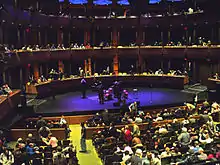Jazz at Lincoln Center
Jazz at Lincoln Center is part of Lincoln Center for the Performing Arts in New York City. The organization was founded in 1987 and opened in October 2004. Wynton Marsalis is the artistic director and the leader of the Jazz at Lincoln Center Orchestra.
 Sign outside Jazz at Lincoln Center | |

| |
| Address | Broadway at 60th Street |
|---|---|
| Location | New York City |
| Coordinates | 40°46′9″N 73°58′59″W |
| Public transit | New York City Subway: 59th Street–Columbus Circle ( New York City Bus: M7, M10, M11, M20, M66, M104 |
| Owner | Lincoln Center for the Performing Arts |
| Genre(s) | Jazz |
| Capacity | Rose Theater: 1,233 The Appel Room: 483 Dizzy's Club: 140[1] |
| Construction | |
| Built | 2004 |
| Website | |
| www | |
The Center hosts performances by the Orchestra and by visiting musicians. Many concerts are streamed live on the Center's YouTube channel. The Center also presents educational programs in its home buildings, online, and in schools throughout the country.
History

In 1987, trumpeter Wynton Marsalis was involved in starting the Classical Jazz concert series, the first series of jazz concerts at Lincoln Center.[2]
In 1996, the Jazz at Lincoln Center organization became a constituent of Lincoln Center next to organizations such as the New York Philharmonic and the Metropolitan Opera. The budget for Jazz at Lincoln Center was $4 million in 1996, compared to $150 million for the Metropolitan Opera.[3] In 2016, its budget was over $50 million.[4] Wynton Marsalis has been artistic director since 1987. Greg Scholl became executive director in 2012.[5]
Marsalis leads the Jazz at Lincoln Center Orchestra, which performs in the Appel Room and the Rose Theater in addition to extensive international tours. Concerts are also broadcast live online. Educational programs are broadcast on the Center's YouTube channel. Since 2015, the Orchestra's albums have been issued on its own label, Blue Engine Records.[2]
The Center distributes jazz curriculums to high schools through its Essentially Ellington program. Professional musicians visit schools through the Let Freedom Swing program. The Center runs a Middle School Jazz Academy, a High School Jazz Academy, and a Summer Academy, all in New York City, all of them with free tuition. Every year the Orchestra tours and visits schools throughout the U.S.[2] The Essentially Ellington High School Jazz Band Competition and Festival has supported high school jazz bands nationwide.
Rose Hall

| Buildings of Lincoln Center |
Buildings and structures in Lincoln Center: 1 2 3 4 5 6 7 8 9 10 11 12 13 |
The performing arts complex, Frederick P. Rose Hall, was designed by Rafael Viñoly. Rose Hall consists of three venues: Rose Theater, The Appel Room,[6] and Dizzy's Club, named after trumpeter Dizzy Gillespie. The Hall also contains the Irene Diamond Education Center with rehearsal and recording rooms.
Hall of Fame
The Nesuhi Ertegun Jazz Hall of Fame is named for Nesuhi Ertegun, co-founder of Atlantic Records. A 60-person international voting panel, which includes musicians, scholars and educators from 17 countries, is charged to nominate and select "the most definitive artists in the history of jazz for induction into the Hall of Fame".[7]
Inductees have included:
2004
- Louis Armstrong (1901–1971), trumpeter
- Sidney Bechet (1897–1959), saxophonist
- Bix Beiderbecke (1903–1931), cornetist
- John Coltrane (1926–1967), saxophonist
- Miles Davis (1926–1991), trumpeter
- Duke Ellington (1899–1974), pianist
- Dizzy Gillespie (1917–1993), trumpeter
- Coleman Hawkins (1904–1969), saxophonist
- Billie Holiday (1915–1959), vocalist
- Thelonious Monk (1917–1982), pianist
- Jelly Roll Morton (1890–1941), pianist
- Charlie Parker (1920–1955), saxophonist
- Art Tatum (1909–1956), pianist
- Lester Young (1909–1959), saxophonist
2005
- Count Basie (1904–1984), pianist, organist
- Roy Eldridge (1911–1989), trumpeter
- Ella Fitzgerald (1917–1996), vocalist
- Benny Goodman (1909–1986), clarinetist
- Earl Hines (1903–1983), pianist
- Johnny Hodges (1907–1970), saxophonist
- "Papa" Jo Jones (1911–1985), drummer
- Charles Mingus (1922–1979), bassist
- Joe "King" Oliver (1885–1938), cornetist
- Max Roach (1924–2007), drummer
- Sonny Rollins (1930– ), saxophonist
- Fats Waller (1904–1943), pianist, organist
2007
- Clifford Brown (1930–1956), trumpeter
- Benny Carter (1907–2003), saxophonist, clarinetist, trumpeter
- Charlie Christian (1916–1942), guitarist
- Django Reinhardt (1910–1953), guitarist
2008
- Ornette Coleman (1930-2015), free jazz pioneer
- Gil Evans (1912–1988), jazz arranger
- Bessie Smith (1894–1937), blues singer
- Mary Lou Williams (1910–1981), pianist, arranger
2010
- Bill Evans (1929–1980), pianist, composer
- Bud Powell (1924–1966), pianist
- Billy Strayhorn (1915–1967), composer, pianist, lyricist, arranger
- Sarah Vaughan (1924–1990), vocalist
2013
- Art Blakey (1919–1990), drummer, bandleader
- Lionel Hampton (1908–2002), vibraphonist, pianist, percussionist, bandleader
- Clark Terry (1920-2015), flugelhornist, trumpeter
2014
- Betty Carter (1929–1998), vocalist
- Fletcher Henderson (1897–1952), pianist, bandleader, arranger, composer
- Elvin Jones (1927–2004), drummer
- Wes Montgomery (1923–1968), guitarist
References
- Venues, jazz.org
- Russonello, Giovanni (13 September 2017). "At 30, What Does Jazz at Lincoln Center Mean?". The New York Times. Retrieved 27 May 2018.
- Pareles, Jon (2 July 1996). "Critic's Notebook: Jelly Roll and the Duke Join Wolfgang and Ludwig". The New York Times. Retrieved 27 May 2018.
- Reich, Howard (3 October 2017). "Wynton Marsalis and Jazz at Lincoln Center celebrate 30 years of spreading the music". Chicago Tribune. Retrieved 27 May 2018.
- https://artsbeat.blogs.nytimes.com/2012/04/25/jazz-at-lincoln-center-names-a-new-executive-director/
- Lucy Cohen Blatter (26 February 2014). "A Room by Any Other Name". The Wall Street Journal.
- Induction process JALC website. Retrieved September 2, 2008.
External links
 Media related to Jazz at Lincoln Center at Wikimedia Commons
Media related to Jazz at Lincoln Center at Wikimedia Commons- Official website